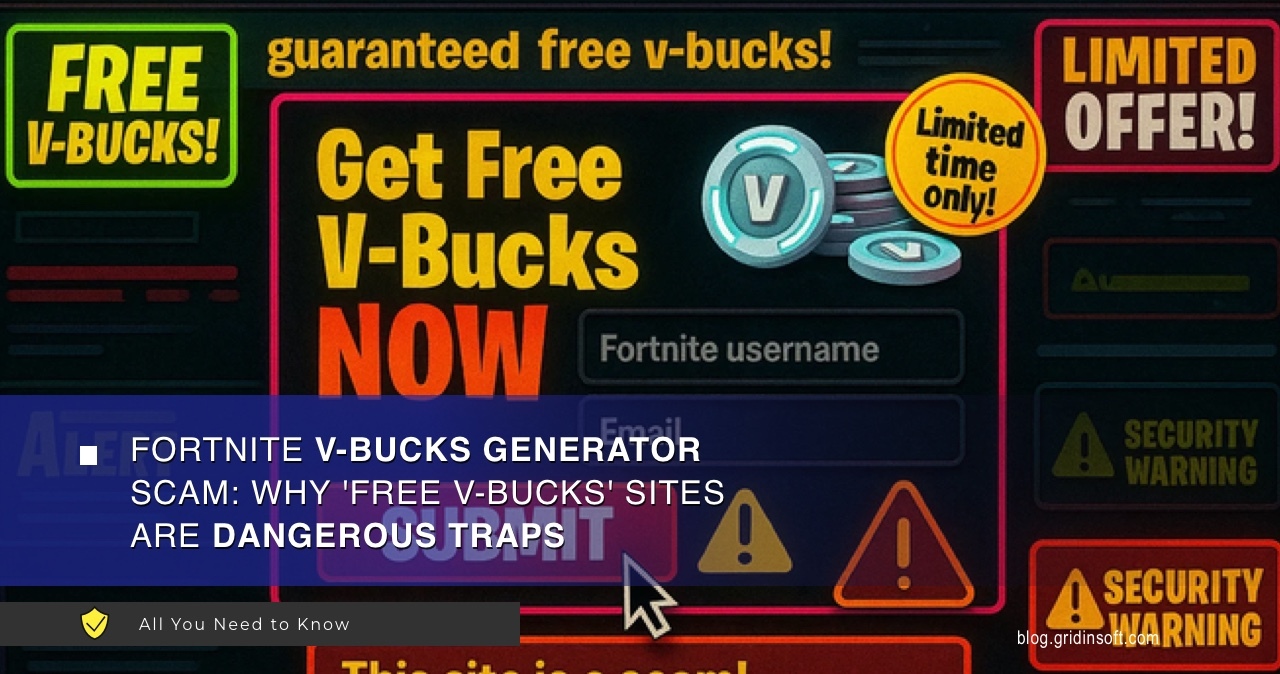When you see a website promising free Fortnite V-Bucks, you’re looking at a carefully crafted trap. These sites can’t actually generate V-Bucks—that’s technically impossible—but they’re extremely good at stealing your account information, infecting your device with malware, and collecting personal data they can sell to other criminals.
- Threat Summary
- Technical Analysis of V-Bucks Generator Operations
- V-Bucks Infrastructure and Generation Impossibility
- Security Risks and Attack Vectors
- Technical Indicators and Domain Analysis
- Legitimate V-Bucks Acquisition Methods
- The Broader Gaming Scam Ecosystem
- Protecting Young Gamers
- The Industry Response
- Taking Action Against Scams
- Frequently Asked Questions (FAQ)
- Looking Forward
- Conclusion
Analysis of domains like 750ge.com, Ggfn.us (you can find more here and here) reveals standard phishing techniques combined with malware distribution mechanisms. The sites exploit Fortnite’s popularity to target users who want free premium content, using social engineering tactics similar to Roblox scams and other online fraud schemes.
Threat Summary
| Threat Name | “Fortnite V-Bucks Generator” Scam Website |
| Threat Type | Phishing, Scam, Social Engineering, Fraud, Malware Distribution |
| Fake Claim | Users can generate V-Bucks (Fortnite in-game currency) for free |
| Related Domains | 750ge.com, ggfn.us, vbbv.store, vuxgou.com, an1.is, moviezone.shop |
| Distribution Methods | SEO poisoning, compromised websites, malicious ads, social media spam, gaming forums |
| Target Platforms | Windows, macOS, Android, iOS, gaming consoles |
| Potential Damage | Account theft, malware infections, financial loss, identity theft, personal data harvesting |
| Common Payloads | InfoStealer malware, banking trojans, adware, cryptocurrency miners, ransomware |
Analysis of domains like 750ge.com, Ggfn.us (you can find more here and here) reveals standard phishing techniques combined with malware distribution mechanisms. The sites exploit Fortnite’s popularity to target users who want free premium content, using social engineering tactics to bypass security awareness.

Epic Games has confirmed that no legitimate V-Bucks generators exist outside their official platforms. Any site claiming otherwise is operating a fraud scheme that poses significant security risks to users.
Technical Analysis of V-Bucks Generator Operations
V-Bucks generator sites follow a standardized attack pattern designed to maximize data collection and malware distribution. The process typically involves four stages: initial attraction, credential harvesting, verification exploitation, and payload delivery.
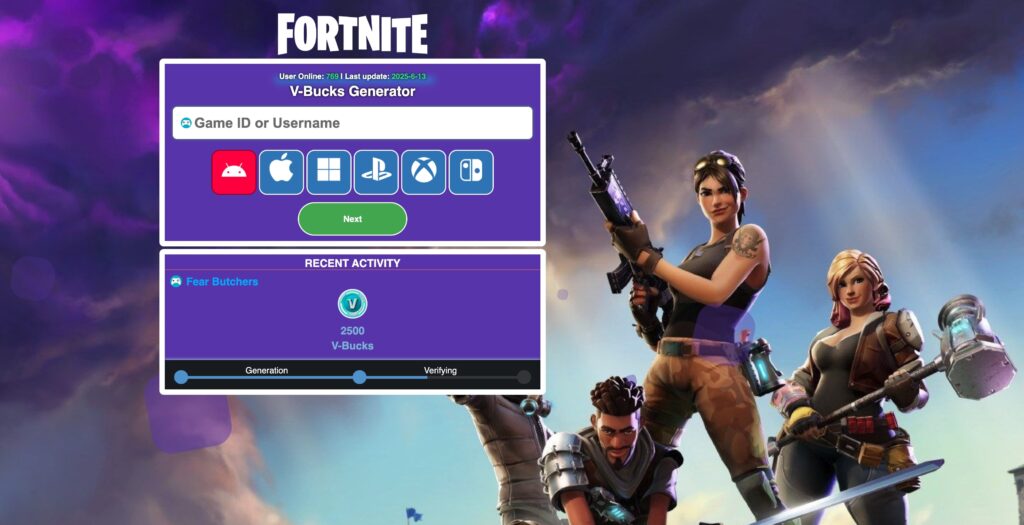
Stage one uses current Fortnite branding and references to recent game updates to establish credibility. Sites often copy official Epic Games visual elements and use domain names that suggest legitimacy while avoiding direct trademark infringement.
Stage two collects user identifiers including Fortnite usernames, platform selections, and desired V-Buck amounts. This data serves multiple purposes: account targeting for future attacks, platform-specific malware selection, and psychological commitment techniques that increase completion rates.
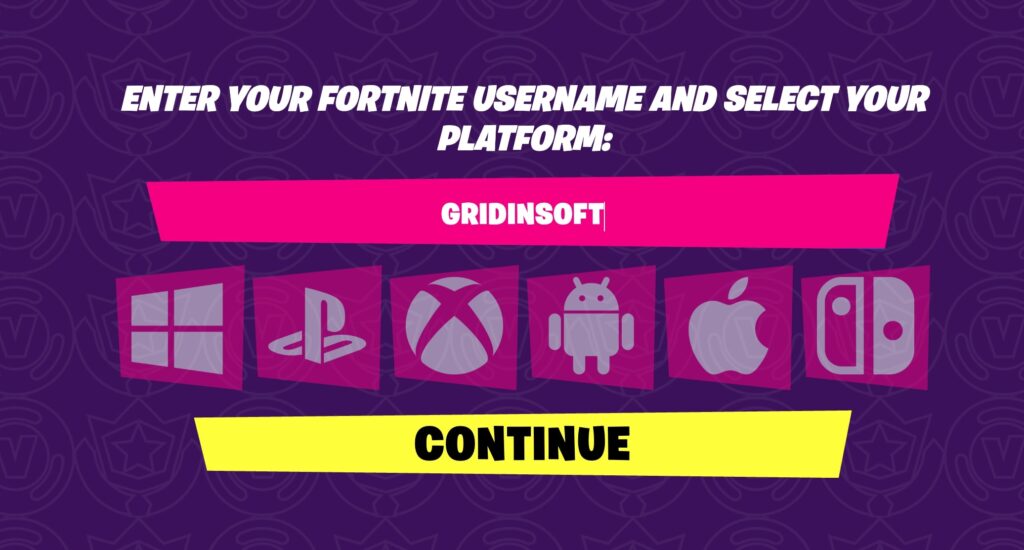
Stage three implements “human verification” mechanisms that serve as delivery vectors for malicious content. These include forced mobile app installations, survey completions that harvest personal information, social media sharing requirements that spread the scam, and direct credential capture attempts.

Stage four delivers the actual payload, which varies by target platform and user value assessment. High-value targets may receive banking trojans or cryptocurrency stealers, while general users typically encounter adware or basic information stealers.
Technical Analysis: JavaScript Tracking Infrastructure
Analysis of the 750get.com JavaScript code reveals tracking mechanisms. The site uses immediately invoked function expressions (IIFE) to inject tracking pixels and affiliate identifiers without user knowledge:
(function () {var it_id=4415856;var html="...
The identifier `4415856` appears across multiple domains including both 750get.com and ggfn.us, confirming these sites operate as part of a coordinated criminal network. This shared affiliate tracking code demonstrates centralized infrastructure management, revenue attribution systems, and organized distribution of compromised user data among network participants.
Cross-domain analysis reveals identical JavaScript implementations across the scam network:
// Found on both 750get.com and ggfn.us
(function () {var it_id=4415856;var html="...
This code replication indicates professional criminal operations with standardized tracking infrastructure, shared revenue models, and coordinated technical deployment across multiple domains. The consistent affiliate ID usage allows network operators to track user interactions across different entry points and attribute successful compromises to specific campaign sources.
V-Bucks Infrastructure and Generation Impossibility
External websites cannot interact with Epic Games’ V-Bucks API because it requires authenticated access through Epic’s OAuth 2.0 implementation, CSRF tokens, and validated payment processor integration. Third-party sites lack the necessary certificates, API keys, and server-side authentication required for legitimate V-Bucks transactions.
Epic’s official documentation specifies four legitimate acquisition methods: direct purchase through authorized platforms, Fortnite Crew subscription, Battle Pass progression rewards, and Save the World mode earnings. All methods require authenticated transactions through Epic’s payment processing system.
Security Risks and Attack Vectors
V-Bucks generator sites present multiple attack vectors targeting user accounts, devices, and personal information. Account compromise occurs through credential theft, session hijacking, and authentication bypass techniques that allow unauthorized access to Epic Games accounts and associated payment methods.
Malware distribution happens primarily through the verification stage, where users download mobile applications or browser extensions containing information stealers, banking trojans, and cryptocurrency wallet extractors. Common families include Stealer-type malware targeting browser credentials, AutoFill data, and local wallet files.
What makes these scams particularly dangerous is how much personal information they collect. Beyond obvious details like your name and email, they’re harvesting your gaming habits, spending patterns, and even information about your friends and family. This data gets sold on dark web marketplaces where criminals pay premium prices for gaming-focused profiles—especially those belonging to young users with access to parents’ payment methods.
These criminal networks don’t just rely on fake websites. They also plant malicious ads on legitimate sites, exploit security holes in web browsers, and even hijack internet traffic to redirect you from real gaming sites to their fake ones. You might think you’re visiting Epic Games’ official website, but end up on a convincing replica designed to steal your login credentials.
Technical Indicators and Domain Analysis
Scam identification relies on specific technical indicators rather than subjective assessment. Domain analysis reveals patterns in DNS registration, SSL certificate authorities, and hosting infrastructure that distinguish legitimate services from fraudulent operations.
Real V-Bucks can only come from a handful of places: Epic Games’ own websites, your console’s official store, or verified app stores like Google Play and the App Store. That’s it. Any other website claiming to sell or give away V-Bucks is lying—they simply don’t have the technical access to Epic’s payment systems that would make this possible.
Infrastructure analysis shows scam sites typically use shared hosting services, generic SSL certificates from free authorities, and domain registrations through privacy services that hide owner information. Legitimate gaming services use dedicated hosting, Extended Validation certificates, and transparent business registration.
URL structure examination reveals additional indicators: legitimate platforms use consistent subdomain patterns, HTTPS enforcement, and standardized API endpoints. Scam sites often employ URL shorteners, mixed HTTP/HTTPS protocols, and randomized path structures to evade detection.
Network behavior analysis shows scam sites frequently redirect users through multiple domains, implement anti-analysis techniques like user-agent filtering, and serve different content based on geographic location or referrer information.
Legitimate V-Bucks Acquisition Methods
Epic Games implements four authenticated V-Bucks acquisition channels, each with specific technical requirements and transaction verification processes. All legitimate methods require authenticated API calls to Epic’s payment processing system with valid user tokens and platform-specific payment verification.
Direct purchase transactions occur through Epic’s payment API integration with authorized payment processors including PayPal, Stripe, and platform-specific billing systems. Transactions require two-factor authentication, encrypted payment token validation, and real-time fraud detection before V-Bucks allocation to user accounts.
Fortnite Crew subscriptions utilize recurring billing APIs that automatically process monthly payments and distribute 1,000 V-Bucks plus Battle Pass access through Epic’s subscription management system. The subscription service validates payment status before each monthly V-Bucks distribution.
Battle Pass V-Bucks distribution happens through Epic’s progression tracking system, which validates challenge completion against server-side records before releasing V-Bucks rewards. The system typically provides 1,300-1,500 V-Bucks for completed Battle Pass progression, requiring 950 V-Bucks initial investment.
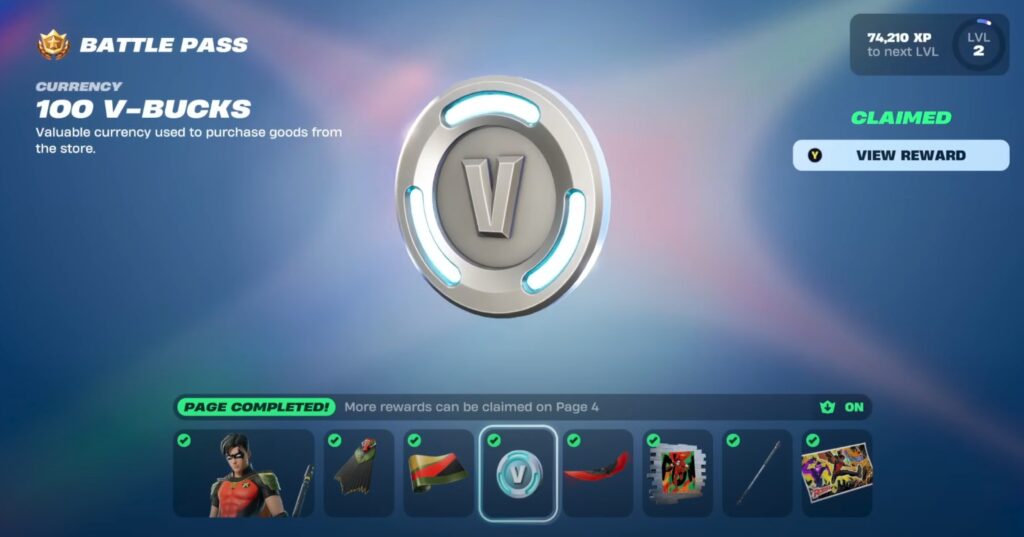
Save the World mode V-Bucks generation operates through Epic’s PvE progression API, tracking daily login streaks, mission completions, and achievement unlocks. This system validates user progress against anti-cheat systems before distributing V-Bucks rewards through the same secure API used for purchases.
The Broader Gaming Scam Ecosystem
V-Bucks generators represent just one facet of a larger criminal ecosystem targeting gamers. Similar scams exist for virtually every popular game with in-game currency. Roblox Robux generators target younger players, while cryptocurrency-based games face their own unique threats.
What’s frustrating is how well these tactics work. Scammers know that gamers—especially younger ones—desperately want premium content and might take risks to get it for free. They’ve perfected the art of making fake sites look authentic, complete with stolen logos, fake testimonials, and countdown timers that create artificial urgency similar to online shopping scams.
These operations are often international, making law enforcement difficult. Scammers register domains in countries with lax regulations and use hosting providers that don’t verify customer identities. This makes shutting down individual sites a game of whack-a-mole, with new domains appearing as fast as old ones are removed—a pattern we see in Telegram scams and other evolving fraud schemes.
The financial incentives are substantial. A successful scam site can compromise thousands of accounts, each potentially worth hundreds of dollars in stolen content or unauthorized purchases. The personal information collected can be sold to other criminals, creating multiple revenue streams from a single operation. This data often ends up in InfoStealer malware databases used for identity theft and account takeovers.
Protecting Young Gamers
Parents and guardians face particular challenges protecting children from these scams. Young gamers are natural targets because they often lack the experience to recognize sophisticated deception and may not understand the consequences of sharing personal information online. Similar to sextortion scams that target young people, these gaming scams exploit trust and inexperience.
Rather than simply forbidding gaming sites, explaining the reality works better. When kids understand that V-Buck generators are literally impossible—like claiming to print real money on a home printer—they become naturally skeptical. Show them how Epic Games actually makes money (by selling V-Bucks) and why they’d never give that revenue away for free.
Setting up proper account security is crucial. Two-factor authentication should be enabled on all gaming accounts, and parents should receive notifications about account changes and purchases. Many gaming platforms offer parental controls that can limit spending and prevent unauthorized account modifications. Consider using parental control software to monitor and protect young users’ online activities.
Regular conversations about online safety help children feel comfortable reporting suspicious websites or unexpected contact from strangers. Creating an environment where children can ask questions without fear of punishment encourages them to seek help when they encounter potential threats. Teach them to recognize common scam warning signs and social engineering tactics used by cybercriminals.
The Industry Response
Gaming companies have become increasingly active in combating these scams, though their efforts face significant challenges. Epic Games regularly reports scam sites to hosting providers and domain registrars, but new sites appear faster than old ones can be shut down.
Social media platforms have implemented policies against scam advertisements, but enforcement remains inconsistent. YouTube, where many users first encounter these scams, has improved its detection of scam content but still struggles with the volume of new uploads.
The development of blockchain gaming and cryptocurrency integration has created new opportunities for scammers, who now promise free tokens and NFTs alongside traditional in-game currency. This evolution requires constant vigilance from both companies and users.
Industry cooperation has improved, with gaming companies sharing information about scam operations and coordinating responses. However, the international nature of many scam operations limits the effectiveness of legal action.
Taking Action Against Scams
Individual users can contribute to the fight against gaming scams by reporting suspicious sites and content. Epic Games provides official channels for reporting scam sites, and most social media platforms have mechanisms for reporting fraudulent content. Consider also reporting to cybersecurity organizations that track online scam patterns.
If you encounter a V-Buck generator scam, documenting and reporting it helps protect other users. Screenshots of the scam process, domain names, and any associated social media accounts provide valuable information for investigators. Share your experience on gaming forums and communities to warn others about new scam techniques.
Sharing knowledge within gaming communities helps spread awareness. When friends or family members mention “free V-Bucks” opportunities, taking time to explain why these are scams can prevent them from becoming victims. Create a culture of security awareness in your gaming groups.
Installing proper security software like Gridinsoft Anti-malware provides protection against malware distributed through scam sites. While prevention is always preferable, having tools to detect and remove malicious software provides important backup protection.

Download and install Anti-Malware by clicking the button below. After the installation, run a Full scan: this will check all the volumes present in the system, including hidden folders and system files. Scanning will take around 15 minutes.
After the scan, you will see the list of detected malicious and unwanted elements. It is possible to adjust the actions that the antimalware program does to each element: click "Advanced mode" and see the options in the drop-down menus. You can also see extended information about each detection - malware type, effects and potential source of infection.
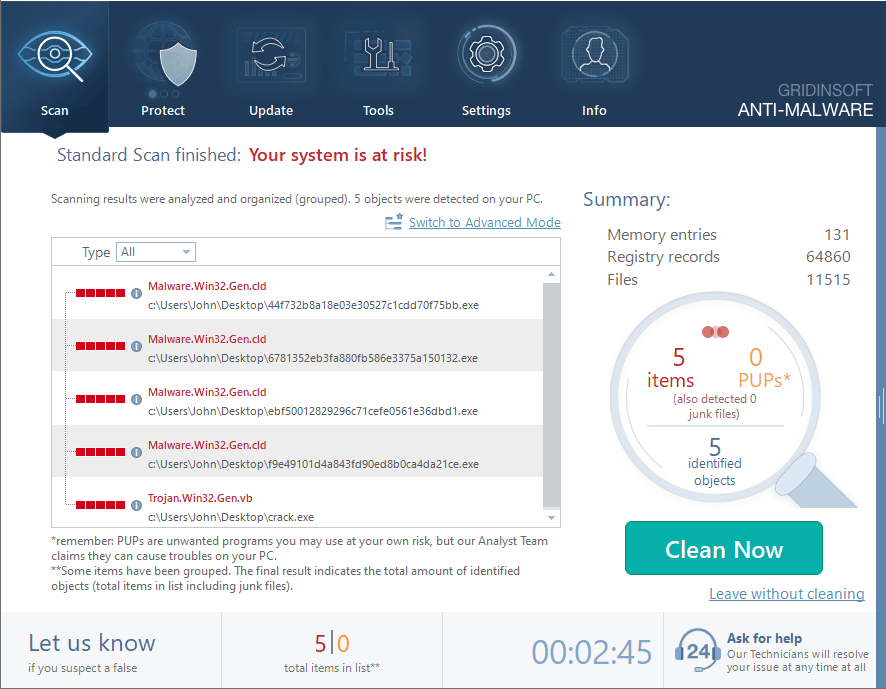
Click "Clean Now" to start the removal process. Important: removal process may take several minutes when there are a lot of detections. Do not interrupt this process, and you will get your system as clean as new.
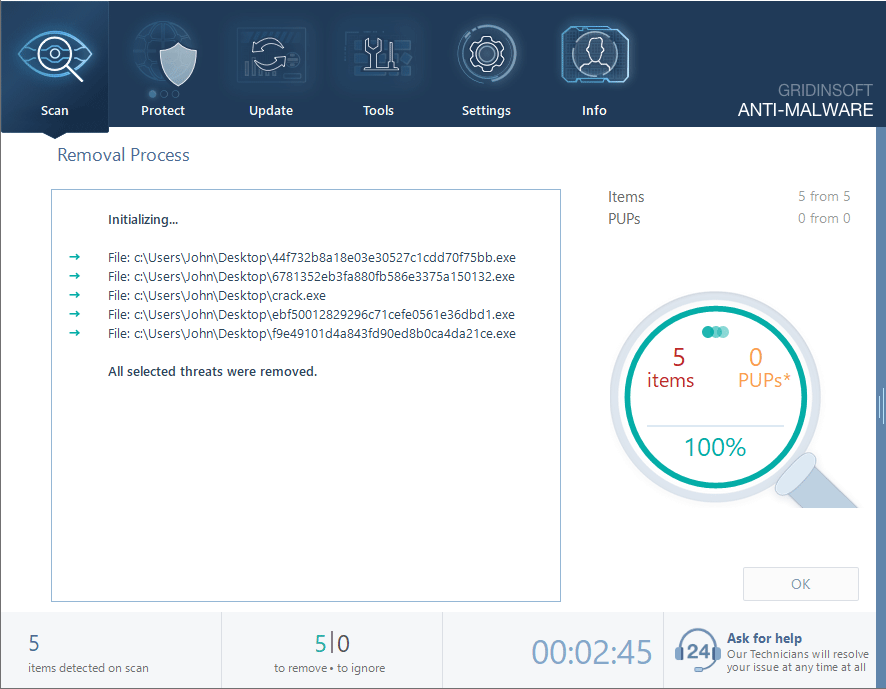
Frequently Asked Questions (FAQ)
What is a “Fortnite V-Bucks Generator” scam?
A V-Bucks generator scam is a deceptive website that falsely promises to generate free V-Bucks (Fortnite’s in-game currency) for users. These sites cannot actually generate V-Bucks—which exist only on Epic Games’ secure servers—but instead steal personal information, distribute malware, or redirect users to other scam sites. They exploit the popularity of Fortnite to target users, especially younger players who want premium content without paying.
How do V-Bucks generator scams work?
These scams typically follow a four-stage process: First, they attract users with promises of free V-Bucks using official Fortnite branding. Second, they collect user information like Fortnite usernames and desired V-Buck amounts. Third, they implement fake “human verification” steps that require downloading apps, completing surveys, or sharing personal data. Finally, they deliver malware, steal credentials, or redirect to other fraudulent sites. No actual V-Bucks are ever generated.
How did I encounter a V-Bucks generator scam?
V-Bucks generator scams are promoted through multiple channels including malicious advertisements, compromised websites, SEO poisoning that makes them appear in search results, social media spam, gaming forum posts, and potentially unwanted applications. Some users encounter them through fake CAPTCHA sites or while searching for legitimate Fortnite content.
Why can’t external websites actually generate V-Bucks?
V-Bucks are digital tokens stored exclusively on Epic Games’ secure backend infrastructure. External websites cannot interact with Epic’s V-Bucks API because it requires authenticated access through Epic’s OAuth 2.0 system, CSRF tokens, and validated payment processor integration. Third-party sites lack the necessary certificates, API keys, and server-side authentication. Only Epic Games’ official platforms can create or distribute legitimate V-Bucks.
What should I do if I fell for a V-Bucks generator scam?
If you’ve interacted with a V-Bucks generator scam, take immediate action: Change your Epic Games password and enable two-factor authentication, scan your device with reputable antivirus software like Gridinsoft Anti-malware, clear your browser data and remove suspicious extensions, monitor your financial accounts for unauthorized transactions, and consider placing fraud alerts if you shared personal information. Contact Epic Games support if you suspect your account has been compromised.
How can I protect myself from V-Bucks generator scams?
Protect yourself by understanding that V-Bucks generators are technically impossible, only purchasing V-Bucks through Epic Games’ official channels, avoiding suspicious links and advertisements, keeping your security software updated, enabling two-factor authentication on gaming accounts, and educating young gamers about these scams. Be especially wary of offers that seem too good to be true or require personal information for “verification.”
Are there legitimate ways to get free V-Bucks?
Yes, Epic Games provides several legitimate ways to earn V-Bucks: through Battle Pass progression (which provides more V-Bucks than it costs), Fortnite Crew subscription (1,000 V-Bucks monthly), Save the World mode earnings (daily login rewards and mission completions), and occasional promotional events. All legitimate methods require playing the game and are distributed through Epic’s secure systems.
What types of malware do V-Bucks generator sites distribute?
V-Bucks generator sites commonly distribute InfoStealer malware that harvests browser credentials and personal data, banking trojans targeting financial information, adware that displays unwanted advertisements, cryptocurrency miners that use your device’s resources, and ransomware in severe cases. Mobile users may encounter fake apps that request excessive permissions to access contacts, messages, and device storage.
How can I report V-Bucks generator scams?
Report V-Bucks generator scams through Epic Games’ official reporting channels, your country’s cybercrime reporting center, the hosting provider of the scam website, and social media platforms if the scam was promoted there. Include screenshots, domain names, and any associated social media accounts in your reports to help investigators track and shut down these operations.
Looking Forward
The popularity of Fortnite and similar games means V-Buck generator scams will likely continue evolving. As security awareness increases and platforms improve their detection capabilities, scammers adapt their tactics to maintain effectiveness.
Recent trends include more sophisticated social engineering, better website design, and integration with legitimate-looking payment processors. Some scams now use artificial intelligence to generate more convincing promotional content and social media profiles.
The rise of mobile gaming has created new attack vectors, with scammers developing fake mobile apps that promise free in-game currency. These apps often request extensive permissions that allow access to contacts, messages, and other sensitive information.
Education remains the most effective defense against these evolving threats. Users who understand the basic principles of how games work and why free currency generators are impossible will be protected against current scams and better equipped to recognize new variations.
Conclusion
Here’s the bottom line: V-Buck generators are a technical impossibility masquerading as free money. These sites exist solely to steal your information and infect your devices. They can’t access Epic’s servers, can’t generate real V-Bucks, and can’t deliver on any of their promises.
Epic Games has built their payment system like a digital fortress—with multiple layers of security, encrypted connections, and authentication requirements that no external website can bypass. When scammers claim they can generate V-Bucks, they’re not just lying about their product—they’re lying about basic computer science.
Protecting yourself is straightforward: understand that free V-Buck generators can’t exist, enable two-factor authentication on your gaming accounts, and run security software like Gridinsoft Anti-malware to catch any malware these sites might try to install. Stay informed about common scam tactics and teach others about these threats.
Most importantly, treat V-Bucks like real money—because they are. You wouldn’t trust a random website offering free cash, so don’t trust one offering free gaming currency. When in doubt, stick to Epic Games’ official channels and remember: if it sounds too good to be true, it’s probably designed to steal from you. For more protection strategies, check our guides on spotting digital scams, avoiding cryptocurrency fraud, and protecting against InfoStealer malware.

